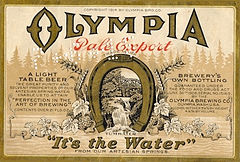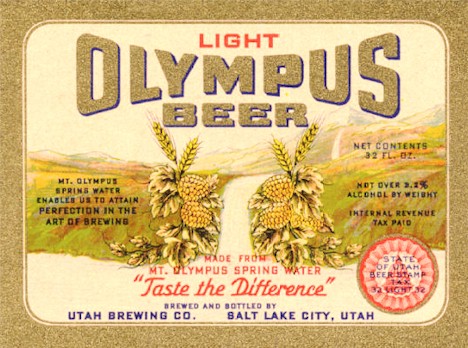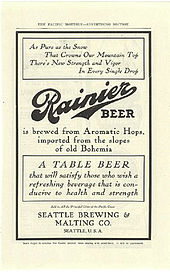Rainier Beer and the brewery date back to 1884, when Edward Sweeney established the Claussen-Sweeney Brewing Company in the Georgetown neighborhood of Seattle.
There was great competition between the Olympic Brewery which was in the town of Olympia on the southern end of the Puget Sound, and the Rainier Brewery in Seattle. Seattle (Sea at ill) had been the place where the indian people gathered their money, which was a coin which you could find by driving a stick from a boat, into the shell beds which were offshore. The money shells had a hole in the middle, but they were difficult to gather. Then Seattle became a timber town, with quite a division between the working classes (men) and the capitalists.
With beer taking about two weeks to brew at that time (1896), it was difficult for the Rainier Brewery established in 1884 in Seattle, to keep up with demand.
What I did was to build a brewery at the top end of the sound. If that makes me Leopold Schmidt, then so be it. There is a picture of it at the top of this page, and it was still there in 1977 when I was living in Olympia. While I was staying at Evergreen we used to raft around the area over the summer, just sunning ourselves and looking at the catfish.
After building the brewery, as I recall most of the actual labouring on the site was done by myself, and the barrels and all that stuff, (buying the copper brewing vessels etc.) it was time to go into production. Once the beer was brewed, it had to be bottled (by hand) while the next batch was brewing. Being a master brewer it was not difficult to produce a superior product using the natural artesian water from the springs above the falls. We used an innovation, Crown bottle caps. According to promotional material, it was possible with the latest technology to cap up to 24 bottles a minute, about 120 dozen per hour. You can see the logistical problem. It was just not easy to keep up with demand. There was a innovation in yeast at the time also, and I managed to obtain a yeast which would complete the fermentation in three days. This enabled me to gain a great advantage over the opposition Rainier Brewery, but the fact that we were located some distance from teh market was not significant as it was a quiet trip up the Puget Sound.
Here is a secret which I can reveal for the first time. We were able to sell 10 bottles for every one we produced. You can call this magic or a miracle, but it was a miracle and it applied equally to our opposition, enabling us to more adequately supply the demand, with a lot more profit of course. Why would God do this? Well I suppose that God knows that thirsty workers like to drink, and sees nothing wrong with that. Prohibition in 1916 in Washington State saw a temporary end to operations.

We owe our success to a legacy of leadership and invention that began in 1892 when our founder, William Painter, invented a better way to package soft drinks and beer. Painter's vision revolutionized the bottling industry. His ingenuity, and the leadership of those who came after him, helped to build Crown Holdings, Inc. into the world-class company it is today
Rainier Beer and the brewery date back to 1884, when Edward Sweeney established the Claussen-Sweeney Brewing Company in the Georgetown neighborhood of Seattle. In 1893, Sweeney's company merged with two other breweries; the new company became known as the Seattle Brewing and Malting Company. Originally, all three of the breweries were operated by this company, but it was the Claussen-Sweeney brewery which would remain in operation until 1999 and become a Seattle landmark. [edit]
The Prohibition Era
Alcoholic beverages were outlawed in Washington state in 1916[2] and the Rainier brand was sold to a San Francisco, California company. Four years later, alcoholic beverages were outlawed nationwide.
The Olympia Brewery brewhouse is at the base of the Tumwater Falls in Tumwater, Washington. The original buildings, constructed in 1896 and reconstructed in 1906, were once the manufacturing site for Olympia Beer. They have long served as a landmark for local residents and drivers along Interstate 5.[1] A new brewery was built in 1934, uphill from the original brewhouse. Brewing operations in a modern plant on the site ended in 2003.
The brewery has been for sale since the collapse of a real estate deal with a bottled water company in 2007.[2] After condemning previous owners' water rights in April 2008, the cities of Lacey, Olympia and Tumwater took possession of water rights once held by the former Olympia Brewing Company.[3]
The original brewhouse is part of the Tumwater Historic District, listed on the National Register of Historic Places.
Olympia Beer was a very popular regional brand in the Pacific Northwest for half of a century. It eventually expanded nationwide, repositioned as a low-price lager. During the 1970s, Olympia acquired Hamm's and Lone Star. Olympia Brewing also produced Buckhorn Beer,[2] which had previously been a product of the Lone Star Brewing Company.[3] The beer declined increasingly in sales when the president of the brewery was caught engaging in a homosexual act, and was therefore publicly outed in the early 1980s. The Schmidt family, which owned and operated the brewery and company, elected to sell the company in 1982. Olympia was subsequently purchased by Pabst in 1983.
As with many other regional breweries, ownership of this brewery eventually passed through several corporations including Pabst, G. Heileman, and Stroh's, until the brewery was eventually purchased by SABMiller. For a time, the Olympia brewery took over the brewing of other Pacific Northwest brands as their original breweries were closed one by one, including the Lucky Lager brewery in Vancouver, Washington, the Henry Weinhard's brewery in Portland, Oregon, and the Rainier Beer brewery in Seattle, Washington. Miller closed the Olympia brewery on July 1, 2003 citing the unprofitability of such a small brewery. However, beer marketed under the Olympia Beer name continues to be manufactured by SABMiller at a plant in Irwindale, California.
1898-Automation
Painter introduces the first
foot-powered, syruper-crowner. A good operator could fill and cap 24
bottles a minute! Painter starts selling crowning equipment and gains
retailers support for the new bottle sealing device.
Rainier Brewing Company (1884–1999) was a Seattle, Washington, company that brewed Rainier Beer, a popular brand in the Pacific Northwest of the United States. Although Rainier was founded in 1884, the Seattle site had been brewing beer since 1878. While the beer enjoys near iconic status, it is no longer brewed in Seattle, nor is the company owned locally. In the late 1990s, the company was sold to Stroh's, then to Pabst Brewing Company, though Miller contract brews most of Pabst's beers. The brewery was closed by Pabst in 1999 and sold.
In 2010, Emerald City Beer Company rented and renovated a portion of the building, brewing the first batch of beer from the Old Rainier Brewery in 11 years on September 23.[1] The brewery itself is a well-known fixture in the south end of town, adjacent to I-5 just north of the Spokane Street Viaduct. The plant is also home to the Tully's Coffee headquarters, Bartholomew Winery, Red Soul Motorcycle Fabrications, as well as artist lofts, band practice spaces, and a recording studio. The trademark red neon "R" that sat atop the building was replaced with a green "T" when Tully's was using the plant to roast coffee. The neon "R" is now in the collection of Seattle's Museum of History and Industry.

A copy-cat immitation of Olympia Beer from Salt Lake city Utah

Seattle has a history of boom and bust cycles, as is common to cities near areas of extensive natural and mineral resources. Seattle has risen several times economically, then gone into precipitous decline, but it has typically used those periods to rebuild solid infrastructure.[39]
The first such boom, covering the early years of the city, was fueled by the lumber industry. (During this period the road now known as Yesler Way was nicknamed "Skid Road",[40] after the timber skidding down the hill to Henry Yesler's sawmill. This is considered a possible origin for the term which later entered the wider American lexicon as Skid Row.)[39] Like much of the American West, Seattle saw numerous conflicts between labor and management, as well as ethnic tensions that culminated in the anti-Chinese riots of 1885–1886.[41] This violence was caused by unemployed whites who determined to drive the Chinese from Seattle (anti-Chinese riots also occurred in Tacoma). Martial law was declared, and federal troops were brought in to put down the disorder. Nevertheless, the economic success in the Seattle area was so great that when the Great Seattle fire of 1889 destroyed the central business district, a far grander city center rapidly emerged in its place.[42] Finance company Washington Mutual, for example, was founded in the immediate wake of the fire.[43] This boom was followed by the construction of a park system, designed by the Olmsted brothers' landscape architecture firm.[39] However, the Panic of 1893 hit Seattle hard.[44]
The second and most dramatic boom and bust resulted from the Klondike Gold Rush, which ended the depression that had begun with the Panic of 1893; in a short time, Seattle became a major transportation center. On July 14, 1897, the S.S. Portland docked with its famed "ton of gold", and Seattle became the main transport and supply point for the miners in Alaska and the Yukon. Few of those working men found lasting wealth, however; it was Seattle's business of clothing the miners and feeding them salmon that panned out in the long run. Along with Seattle, other cities like Everett, Tacoma, Port Townsend, Bremerton, and Olympia, all in the Puget Sound region, became competitors for exchange, rather than mother-lodes for extraction, of precious metals.[46] The boom lasted well into the early part of the 20th century and funded many new Seattle companies and products. In 1907, 19-year-old James E. Casey borrowed $100 from a friend and founded the American Messenger Company (later UPS). Other Seattle companies founded during this period include Nordstrom and Eddie Bauer.[43] The Gold Rush era culminated in the Alaska-Yukon-Pacific Exposition of 1909, which is largely responsible for the layout of today's University of Washington campus.[47]
Beginning with Microsoft's 1979 move from Albuquerque, New Mexico to nearby Bellevue, Washington,[55] Seattle and its suburbs became home to a number of technology companies including Amazon.com, RealNetworks, McCaw Cellular (now part of AT&T Mobility), VoiceStream (now T-Mobile USA), and biomedical corporations such as HeartStream (later purchased by Philips), Heart Technologies (later purchased by Boston Scientific), Physio-Control (later purchased by Medtronic), ZymoGenetics, ICOS (later purchased by Eli Lilly and Company) and Immunex (later purchased by Amgen). This success brought an influx of new citizens with a population increase within city limits of almost 50,000 between 1990 and 2000,[56] and saw Seattle's real estate become some of the most expensive in the country.[57] Many of the Seattle area's tech companies remain relatively strong, but the frenzied dot-com boom years ended in early 2001.[58][5


